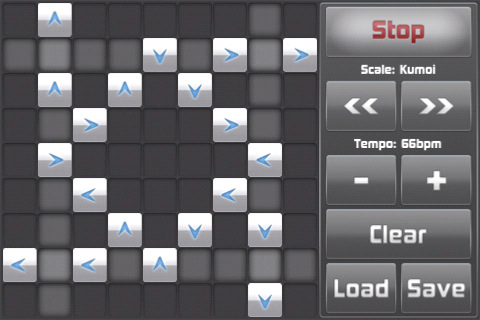

But please do the math, it is possible (but not proven) that there might exist some configurations where the exact repetition would take (billions of billions of times) longer than the known age of our universe. I should have said “(practically) never repeating” above. I’d love it if you give some sort of attribution, still cool if you don’t do it.Ĭ: You are a filthy liar! You can’t create “never repeating” patterns with a system whose state space is finite!Ī: You are right. Q: Can I use the output in my own piece, am I allowed to do that?Ī: By all means do so! Hell do it even if I said no.
#Otomata music game code
Also the code needs a bit of clean-up to be meaningful.Ĭ: I found this bug where the cells move in circles.

I might open source the whole thing while I’m at it. Q: Why can’t I load pieces from other peoples’ links?Ī: You most probably have JavaScript disabled.Ī: I will open source the HaXe DSP library I used to program this. I wrote a DSP library with HaXe and programmed this to try it actually. Sorry.Ī: I programmed this with the HaXe programming language (it is awesome, look it up). I will make a standalone version of this at some point which will emit OSC and MIDI. Always open to suggestions.Ī: I will look into my possibilities for doing this. The ability to change the scale that is used and ability to change the overall tempo is already added in the second release. there are a lot of things that can be added, but I don’t want to clutter things. Here are replies to some common questions:Ī: I really strived for simplicity for this instrument. If you encounter something you like, just press “Copy Piece Link” and save it somewhere, or better, share it! Go add some cells, change their orientation by clicking on them, and press play, experiment, have fun.
#Otomata music game free
A little more than a month ago Bozkurt announced the free tool’s existence on his website. This set of rules produces chaotic results in some settings, therefore you can end up with never repeating, gradually evolving sequences. This is Otomata, the grid-based generative music system, or audio-game, or sound-toy, developed by Batuhan Bozkurt, who is based in Istanbul, Turkey. If a cell encounters another cell on its way, it turns itself clockwise. If any cell encounters a wall, it triggers a pitched sound whose frequency is determined by the xy position of collision, and the cell reverses its direction. at each cycle, the cells move themselves in the direction of their internal states. It employs a cellular automaton type logic I’ve devised to produce sound events.Įach alive cell has 4 states: Up, right, down, left. Update: Click here to get Otomata for your iPhone / iPod / iPad! Otomata will surprise you with your musical skills (whether or not you think they actually exist).You need Flash plugin to experience this content. Press play, lock your device and do your thing with a soothing and constantly evolving musical background! * Support for playing your endless pieces when you lock your device. * Twitter and Facebook integration to share your music with the world * Loaded with best presets chosen by the Otomata community

Stream songs including City Ruins - Rays of Light (From Nier: Automata). * 40 hand picked musical scales for you to play with Listen to Video Game Lofi: Nier: Automata by Floopy & LoFi VGM on Apple Music. When you are satisfied with your piece, you are able to share it with the world using your favorite social networking site, using just your mobile device. You just need to create an initial scene on the cellular grid by tapping on the screen (simple as that!), and Otomata will generate and play endless melodies with beautiful visuals for your enjoyment. Otomata is a generative musical instrument that anyone with or without a music training can enjoy.

If you want to see what Otomata is about, play with it through the web player first: Summary: Enjoy the mobile version of the generative music application that millions enjoyed through the web, with your iOS device!


 0 kommentar(er)
0 kommentar(er)
